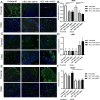Application of Human Epineural Conduit Supported with Human Mesenchymal Stem Cells as a Novel Therapy for Enhancement of Nerve Gap Regeneration
- PMID: 34787795
- PMCID: PMC8930890
- DOI: 10.1007/s12015-021-10301-z
Application of Human Epineural Conduit Supported with Human Mesenchymal Stem Cells as a Novel Therapy for Enhancement of Nerve Gap Regeneration
Abstract
Various therapeutic methods have been suggested to enhance nerve regeneration. In this study, we propose a novel approach for enhancement of nerve gap regeneration by applying human epineural conduit (hEC) supported with human mesenchymal stem cells (hMSC), as an alternative to autograft repair. Restoration of 20 mm sciatic nerve defect with hEC created from human sciatic nerve supported with hMSC was tested in 4 experimental groups (n = 6 each) in the athymic nude rat model (Crl:NIH-Foxn1rnu): 1 - No repair control, 2 - Autograft control, 3 - Matched diameter hEC filled with 1 mL saline, 4 - Matched diameter hEC supported with 3 × 106 hMSC. Assessments included: functional tests: toe-spread and pinprick, regeneration assessment by immunofluorescence staining: HLA-1, HLA-DR, NGF, GFAP, Laminin B, S-100, VEGF, vWF and PKH26 labeling; histomorphometric analysis of myelin thickness, axonal density, fiber diameter and myelinated nerve fibers percentage; Gastrocnemius Muscle Index (GMI) and muscle fiber area ratio. Best sensory and motor function recovery, as well as GMI and muscle fiber area ratio, were observed in the autograft group, and were comparable to the hEC with hMSC group (p = 0.038). Significant improvements of myelin thickness (p = 0.003), fiber diameter (p = 0.0296), and percentage of myelinated fibers (p < 0.0001) were detected in hEC group supported with hMSC compared to hEC with saline controls. At 12-weeks after nerve gap repair, hEC combined with hMSC revealed increased expression of neurotrophic and proangiogenic factors, which corresponded with improvement of function comparable with the autograft control. Application of our novel hEC supported with hMSC provides a potential alternative to the autograft nerve repair.
Keywords: Autograft; Human Epineural conduit; Mesenchymal stem cells; Nerve regeneration; Peripheral nerve repair; Regenerative medicine.
© 2021. The Author(s).
Conflict of interest statement
M.S. is the inventor of the patent application related to Methods of Engineering of Neural Tissue (US/2012/171172A1) and holds a patent on the use of epineural sheath grafts for neural regeneration and protection (WO/2009/124170A1). The authors M.S., M.M.S., K.K., S.B., W.G.K., and J.C. do not have any non-financial conflict of interest.
Figures








Similar articles
-
Application of Human Epineural Patch (hEP) as a Novel Strategy for Nerve Protection and Enhancement of Regeneration After Nerve Crush Injury.Biomedicines. 2025 Jul 3;13(7):1633. doi: 10.3390/biomedicines13071633. Biomedicines. 2025. PMID: 40722706 Free PMC article.
-
Assessment of Human Epineural Conduit of Different Size Diameters on Efficacy of Nerve Regeneration and Functional Outcomes.J Reconstr Microsurg. 2023 Jun;39(5):392-404. doi: 10.1055/s-0042-1758182. Epub 2022 Nov 15. J Reconstr Microsurg. 2023. PMID: 36379456
-
Peripheral nerve defect repair with epineural tubes supported with bone marrow stromal cells: a preliminary report.Ann Plast Surg. 2011 Jul;67(1):73-84. doi: 10.1097/SAP.0b013e318223c2db. Ann Plast Surg. 2011. PMID: 21629045
-
Protective Effect of the Human Epineural Patch Application after Sciatic Nerve Crush Injury Followed by Nerve Transection and End-to-End Repair.Arch Immunol Ther Exp (Warsz). 2025 Mar 26;73(1). doi: 10.2478/aite-2025-0008. eCollection 2025 Jan 1. Arch Immunol Ther Exp (Warsz). 2025. PMID: 40146977
-
Repair of the peripheral nerve gap with epineural sheath conduit to prevent muscle denervation atrophy in the diabetic rat model.Pol Przegl Chir. 2013 Jul;85(7):387-94. doi: 10.2478/pjs-2013-0059. Pol Przegl Chir. 2013. PMID: 23945116
Cited by
-
Comparison of three different strategies to treat sciatic nerve regeneration: an experimental study.Acta Cir Bras. 2022 Aug 12;37(5):e370501. doi: 10.1590/acb370501. eCollection 2022. Acta Cir Bras. 2022. PMID: 35976339 Free PMC article.
-
Promotion of skin wound healing using hypoimmunogenic epidermal cell sheets.Regen Ther. 2023 Jul 20;24:245-255. doi: 10.1016/j.reth.2023.07.003. eCollection 2023 Dec. Regen Ther. 2023. PMID: 37534237 Free PMC article.
-
Peripheral Nerve Protection Strategies: Recent Advances and Potential Clinical Applications.J Funct Biomater. 2025 Apr 24;16(5):153. doi: 10.3390/jfb16050153. J Funct Biomater. 2025. PMID: 40422818 Free PMC article. Review.
-
Benefit of Adjuvant Mesenchymal Stem Cell Transplantation to Critical-Sized Peripheral Nerve Defect Repair: A Systematic Review and Meta-Analysis of Preclinical Studies.J Clin Med. 2023 Feb 7;12(4):1306. doi: 10.3390/jcm12041306. J Clin Med. 2023. PMID: 36835844 Free PMC article.
-
Application of Human Epineural Patch (hEP) as a Novel Strategy for Nerve Protection and Enhancement of Regeneration After Nerve Crush Injury.Biomedicines. 2025 Jul 3;13(7):1633. doi: 10.3390/biomedicines13071633. Biomedicines. 2025. PMID: 40722706 Free PMC article.
References
-
- Noble J, Munro C, Prasad V, Midha R. Analysis of upper and lower extremity peripheral nerve injuries in a population of patients with multiple injuries. The Journal of Trauma. 1998;45(1):116–122. - PubMed
-
- Kouyoumdjian JA, Graça CR, FMF V. Peripheral nerve injuries: A retrospective survey of 1124 cases. Neurology India. 2017;65(3):551–555. - PubMed
-
- Kelsey, J.L., Praemer, A., Nelson, L.M., Felberg, A., Rice, D.P. (1997). Upper extremity disorders: Frequency, impact and cost. New York, Churchill Livingstone, p.26–42.
-
- Campbell WW. Evaluation and management of peripheral nerve injury. Clinical Neurophysiology. 2008;119(9):1951–1965. - PubMed
Publication types
MeSH terms
LinkOut - more resources
Full Text Sources
Research Materials
Miscellaneous

